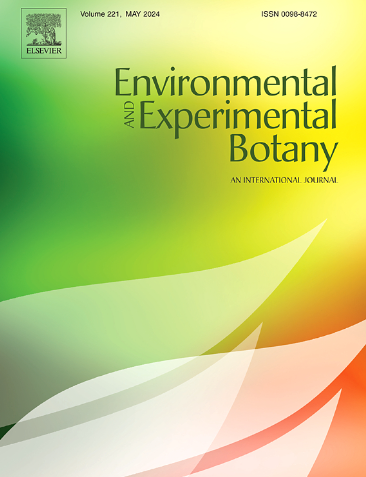Large physiological plasticity of water- and nutrient-use traits in Quercus ilex L. within and across populations: Implications for Mediterranean forest persistence under global change
IF 4.5
2区 生物学
Q2 ENVIRONMENTAL SCIENCES
引用次数: 0
Abstract
Functional traits are essential for predicting plant responses to environmental changes, yet understanding within-species trait variability is complex due to multiple influencing factors. Long-lived trees, like the holm oak (Quercus ilex L.), are expected to respond to abiotic variations largely through phenotypic plasticity, so a better understanding of these plastic responses is key to managing climate change impacts on forests. To investigate intra-specific variations in ecophysiological performance under dry Mediterranean conditions, we measured isotopic, nutrient, and growth traits in 240 four-year-old holm oaks from various populations and mother trees grown in a common garden experiment. Contrary to expectations, we found little ecotypic differentiation in isotopic, nutrient, or growth traits among geographically distant populations with contrasting climates, elevations, and lithologies. Leaf Δ¹⁸Oenrichment and δ13C values ranged widely across and within populations, indicating large variability in time-integrated stomatal conductance and water-use efficiency among neighboring oaks grown under the same dry conditions. Both Δ¹⁸Oenrichment and δ13C exhibited negative relationships with leaf C/P and C/K ratios, revealing a trade-off between water-use efficiency and nutrient-use efficiency that was primarily driven by changes in stomatal regulation stringency depending on leaf nutrient status. Holm oaks from all populations were capable of fine-tuning their leaf gas exchange to prioritize efficient use of the most limiting resource for photosynthesis and growth (water versus nutrients). Phosphorus deficiency and stoichiometric N/P imbalance led to lower water-use efficiency and poorer growth. We conclude that all studied holm oak populations possess sufficient phenotypic plasticity and/or genetic diversity to withstand heat and drought stress intensification through adaptive adjustments of their physiological and nutrient traits. Nonetheless, phosphorus fertilization could greatly enhance forest restoration success amid increasing climatic aridity and human-driven N/P imbalance. These findings hold important implications for a better understanding of holm oaks persistence under rapid climate warming and aridification across the Mediterranean region.
冬青栎种群内和种群间水分和养分利用性状的巨大生理可塑性:全球变化下地中海森林持久性的影响
功能性状对于预测植物对环境变化的响应是必不可少的,但由于多种影响因素,对物种内性状变异的理解是复杂的。长寿的树木,如黑栎(Quercus ilex L.),预计主要通过表型可塑性对非生物变化做出反应,因此更好地了解这些可塑性反应是管理气候变化对森林影响的关键。为了研究地中海干旱条件下生态生理性能的种内变化,我们测量了240棵4年生霍尔姆橡树的同位素、营养和生长性状,这些橡树来自不同的种群和母树,生长在一个普通的花园实验中。与预期相反,我们发现在气候、海拔和岩性不同的地理距离较远的种群中,同位素、营养物质或生长性状的生态型差异很小。叶片Δ¹⁸Oenrichment和Δ 13c值在种群间和种群内差异很大,表明在相同干旱条件下相邻栎树间气孔导度和水分利用效率的时间综合差异很大。Δ¹⁸氧富集和Δ 13c均与叶片C/P和C/K呈负相关,表明水分利用效率和养分利用效率之间的权衡主要由叶片养分状态下气孔调节强度的变化所驱动。所有种群的霍尔姆橡树都能够微调叶片气体交换,优先有效利用最有限的资源进行光合作用和生长(水与养分)。缺磷和化学计量氮磷失衡导致水分利用效率降低和生长不良。我们认为,所有研究的黑栎种群都具有足够的表型可塑性和/或遗传多样性,可以通过生理和营养性状的适应性调整来抵御高温和干旱胁迫的加剧。然而,在气候日益干旱和人类驱动的N/P失衡的情况下,磷肥可以极大地提高森林恢复的成功率。这些发现对于更好地理解霍尔姆橡树在地中海地区快速气候变暖和干旱化下的持久性具有重要意义。
本文章由计算机程序翻译,如有差异,请以英文原文为准。
求助全文
约1分钟内获得全文
求助全文
来源期刊

Environmental and Experimental Botany
环境科学-环境科学
CiteScore
9.30
自引率
5.30%
发文量
342
审稿时长
26 days
期刊介绍:
Environmental and Experimental Botany (EEB) publishes research papers on the physical, chemical, biological, molecular mechanisms and processes involved in the responses of plants to their environment.
In addition to research papers, the journal includes review articles. Submission is in agreement with the Editors-in-Chief.
The Journal also publishes special issues which are built by invited guest editors and are related to the main themes of EEB.
The areas covered by the Journal include:
(1) Responses of plants to heavy metals and pollutants
(2) Plant/water interactions (salinity, drought, flooding)
(3) Responses of plants to radiations ranging from UV-B to infrared
(4) Plant/atmosphere relations (ozone, CO2 , temperature)
(5) Global change impacts on plant ecophysiology
(6) Biotic interactions involving environmental factors.
 求助内容:
求助内容: 应助结果提醒方式:
应助结果提醒方式:


